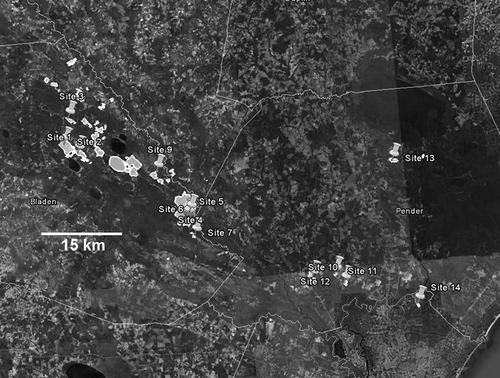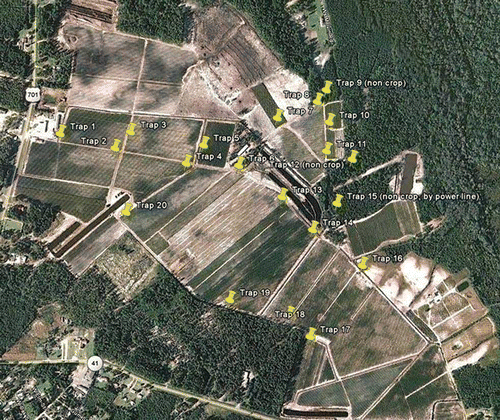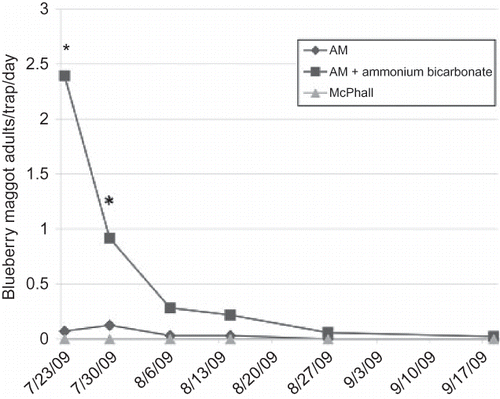Abstract
The blueberry maggot (Rhagoletis mendax) is one of the most significant pests of blueberry (Vaccinium spp.) in North America because of its potential fruit damage and its export quarantine status. If left unchecked, R. mendax infestations can reach nearly 100%. Larvae feed internally, and infested fruit can be difficult to identify without destructive sampling, making it possible for infested fruit to be missed in the sorting process. Because of this damage potential and cryptic injury, Canada has imposed import restrictions for R. mendax, which is not established in some western blueberry growing regions. Nearly all of North Carolina's blueberry growers export a portion of their crop to Canada and are subject to quarantine restrictions. All of the growers certified for export to Canada currently operate under a scheduled spray program (relying mostly on organophosphate insecticides), even though the Canadian phytosanitary protocol allows for a monitoring based (and likely reduced insecticide) management regime. We conducted blueberry maggot monitoring at 14 North Carolina blueberry fields to determine the feasibility of implementing a monitoring based R. mendax management program and to assess the potential insecticide reduction under such a monitoring based program. Results from 2010 indicate that significant reductions in insecticide applications could be achieved if monitoring was implemented.
INTRODUCTION
Farm scale pest management decisions are driven by many, often competing, factors, and although economic status of the target pest should be the primary management concern, often non-biological drivers elicit greater force. This is the case with respect to blueberry maggot management in the North Carolina blueberry agroecosystem. Blueberry maggot, Rhagoletis mendax (Curan), is an oligophagous pest of cultivated blueberries found throughout the eastern United States. R. mendax is not, however, present in the western U.S. or western Canada. In order to protect Canadian blueberry production from the introduction of R. mendax, which can, if left unchecked result in near total fruit infestation, the Canadian Food Inspection Agency has imposed quarantine for R. mendax on fruit imported from areas where the fly is present. This quarantine covers North Carolina in addition to many other states.
Blueberries are grown on an estimated 2,460 hectares in North Carolina, the majority of which are in Bladen, Duplin, Pender, and Sampson Counties in the southeastern part of the state (CitationCline et al., 2005). Field size in this area ranges from approximately 16 hectares to over 203 hectares. A single field typically includes several varieties, both southern highbush and rabbiteye, which flower and mature fruit at different times. Fruit susceptible to R. mendax infestation are typically available from mid May through the end of July.
A portion of the wholesale marketed blueberries grown in North Carolina are shipped to Canada and, therefore, are subject to quarantine. Virtually all of North Carolina blueberry growers who export a portion of their crop treat all of it for R. mendax to ensure they meet the Canadian import requirement. The Canadian Blueberry Certification Program (BCP) has been in place since 1999 and specifies two R. mendax management strategies, the Calendar method and the IPM (integrated pest management) method (CitationCanadian Food Inspection Agency, 2009). Both of these methods rely on the application of insecticides for R. mendax management, but they differ in the timing and frequency of insecticide applications. Growers following calendar treatments begin pesticide applications at the first R. mendax capture in the area or state, as determined by monitoring traps. Insecticide applications continue every 7–10 days through the end of harvest. Growers following an IPM program establish R. mendax monitoring traps at their farm and apply insecticide within 5 days of the first R. mendax trap capture. At least two insecticide applications must be made following a R. mendax capture, 7–10 days apart. If no additional flies are detected, insecticide applications cease until trap captures resume. Any insecticide registered for R. mendax or recommended by extension specialists can be used. The majority of export certified North Carolina blueberry growers currently use ultra low volume formulations of malathion, an organophosphate insecticide, as their primary R. mendax material. Malathion is preferred because of its short (1 day) preharvest interval, low relative cost, broad spectrum activity, and ease of aerial application. Recent concerns have been raised about organophosphate insecticide use in fruit crops (CitationBouchard et al., 2010) causing some growers and marketers to reevaluate their management strategies.
The North Carolina Department of Agriculture & Consumer Services (NCDA & CS) certifies blueberries for export to Canada and is responsible for notifying growers of when treatments should begin. However, NCDA & CS does not monitor for R. mendax in southeastern North Carolina because no flies have been caught for at least 5 years, and no farms have had maggots in sampled fruit. Calendar treatment start dates are based on an historic 1st trap capture date of May 20. A preliminary monitoring program conducted by our laboratory in 2008 also captured no R. mendax in four trap types deployed (Rebel, Pherocon AM-NB, AM + ammonium bicarbonate, and McPhail). This program included two locations, one with a history of R. mendax captures and one abandoned planting for which the history was unknown (Burrack, unpublished data). All North Carolina growers currently exporting to Canada, and, therefore, the majority of blueberry growers, are certified under the Calendar program. The wholesale adoption of this management method has resulted in almost all of the blueberry fields in southeastern North Carolina receiving multiple aerial applications of malathion yearly.
The low incidence of R. mendax trap captures and infestation in the primary North Carolina blueberry producing area suggests that a reduction in pesticide applications may be possible without comprising export viability and fruit quality. We initiated a monitoring program for R. mendax to determine the distribution and population densities in the major blueberry producing counties in North Carolina. The goal of this program was to provide growers with the information to determine if transition to an IPM management scheme, with potentially fewer insecticide applications, is feasible.
MATERIALS AND METHODS
Fourteen trapping locations were established in southeastern North Carolina () on April 19, 2010. Our monitoring program covered 613 hectares in total, 25% of the total blueberry area in North Carolina. We also established a validation trapping site (Site 15) in western North Carolina on June 3rd at a location with a history of high R. mendax populations to ensure that our monitoring methods were effective. Sites 13, 14, and 15 received no insecticide applications during the monitoring period (). All other locations followed the Calendar method and began aerial applications of malathion during the week of May 17, 2010.
TABLE 1 Monitoring Site Size, Location, Trap Number, and Trap Captures (Sites Indicated by * Received No Insecticide Applications during the Monitoring Period)
FIGURE 1 Sites 1–14. Highlighted areas are known blueberry fields. (Image created via Google Earth, © 2011 Google)

Pherocon AM-NB (Trece, Inc., Adair, OK, USA) traps and external food lures (plastic vials containing 15 g of ammonium bicarbonate) were randomly distributed along accessible pathways throughout each site (). External food lures were considered preferable to Pherocon AM baited traps, which contain an ammonia lure in the sticky matrix because ammonia lures remain attractive for approximately a week under North Carolina field conditions, but the traps themselves are often viable for longer. The AM-NB traps allow for lures to be refreshed, potentially saving on trap costs. Traps were placed in a v-shape with the opening upward in the upper third of fruiting bushes. This trap orientation and placement has been demonstrated efficient in New Jersey blueberry production (CitationLiburd et al., 1998, Citation2000).
FIGURE 2 Trap placement at Site 1, Bladen County, NC. Traps indicated as “non-crop” were placed outside of blueberry planting on white fiberglass step-in fence posts. (Image created via Google Earth, © 2011 Google) (color figure available online).

In 2009, we compared Pherocon AM traps baited with external ammonium bicarbonate food lures, unbaited AM traps, and plastic McPhail-type traps baited with an aqueous torula yeast lure at the location that became Site 15 in 2010. Four replicates of each trap were randomly distributed throughout the planting and checked once per week. Flies captured per trap per day were compared via ANOVA (SAS Proc Mixed). The Pherocon-NB trap baited with ammonium bicarbonate was the most attractive of the three types in this small-scale trial on dates when there were significant differences between trap types (F = 4.3110,51, p = 0.0002) ().
FIGURE 3 R. mendax flies captured per trap per day at Site 15 during 2009 in three trap types. On dates indicated by *, Pherocon-AM traps baited with ammonium bicarbonate food lures captured significantly more flies than the other 2 trap types via LSD (α = 0.05).

Each trap was checked and lures were replaced weekly. Any traps containing R. mendax were removed and returned to the laboratory for identification confirmation and held for validation purposes. If no R. mendax were caught, traps were changed every 4 weeks or sooner if soiled. Grower cooperators were notified immediately if R. mendax were captured at their farm. The number of traps per site was determined by following the recommended trap density required by the Canadian BCP (). Data were entered in a Google Documents spreadsheet and the resulting chart was published as a webpage. This allowed for real-time data sharing with grower cooperators, NCDA & CS, and other interested parties.
TABLE 2 Suggested R. mendax Trap Density (Adapted from CitationCanadian Food Inspection Agency, 2009)
Fruit (25 berries per trap) were randomly collected from the plants containing traps or the two plants directly adjacent to each trap containing plant, depending on fruit availability, on June 17 at Sites 1–14. These fruit were dissected to check for R. mendax larvae.
RESULTS AND DISCUSSION
A total of three flies (two males and one female) were captured at all southeastern sites (), while a total of 165 flies were captured at our western North Carolina validation site. This suggests that our monitoring methods were effective. One female R. mendax fly was captured at Site 5 on May 21, the day before malathion applications began at this location. The fly captures at Sites 2 and 12 both occurred on July 14 and were both male. Trap captures at Site 15 started on June 14 and are ongoing as of July 21. Conventionally treated sites (Sites 1 though 12) received between three and five pesticide applications, beginning the week of May 17 for all. Sites 13, 14, and 15 received no pesticide applications. No larvae were found in any of the dissected flies from samples from Site 1–14. Fruit samples were not collected from Site 15.
The near universal adoption of calendar timed malathion applications for R. mendax has resulted in a de facto-area-wide control program for this insect in southeastern North Carolina. Consequently, R. mendax populations have decreased to below detectable levels at most farms. It is now likely possible and desirable to reduce insecticide applications for R. mendax without compromising fruit quality. Current Canadian import requirements allow for this flexibility, and current monitoring methods appear adequate. It is noteworthy that two flies were caught in July at Sites 2 and 12. These locations both still had abundant rabbiteye fruit, while the other locations had little fruit present. We could not determine the age of these flies in order to understand whether they were long-lived adults that emerged near the first trap capture dates or whether they were members of a later emerging, perhaps rabbiteye adapted, cohort. The later possibility is intriguing and may also have implications for management timing. Our next steps include working with grower cooperators to implement a reduced pesticide application program for R. mendax and assessing the potential non target impacts and benefits of this pesticide reduction.
ACKNOWLEDGMENTS
We wish to thank nine cooperating blueberry growers for allowing access to their farms for monitoring efforts. This research was supported by the North Carolina Blueberry Council, Inc.
LITERATURE CITED
- Bouchard , M.F. , Bellinger , D.C. , Wright , R.O. and Weisskopf , M.G. 2010 . Attention-deficit/hyperactivity disorder and urinary metabolites of organophate pesticides . Pediatrics , 125 : 1270 – 1277 .
- Canadian Food Inspection Agency. 2009. D–02–04: Phytosanitary requirements for the importation from the continental United States and for domestic movement of commodities regulated for blueberry maggot http://www.inspection.gc.ca/english/plaveg/protect/dir/d-02-04e.shtml (http://www.inspection.gc.ca/english/plaveg/protect/dir/d-02-04e.shtml) (Accessed: July 2010 ).
- Cline, W.O., J.R. Meyer, D.W. Monks, K.A. Sorenson, K.M. Jennings, J.R. Ballington, S. Rooks, and S.J. Toth. 2005. Crop profile for blueberries in North Carolina http://www.ipmcenters.org/cropprofiles/docs/ncblueberries.html (http://www.ipmcenters.org/cropprofiles/docs/ncblueberries.html) (Accessed: July 2010 ).
- Liburd , O.E. , Alm , S.R. , Casagrande , R.A. and Polavarapu , S. 1998 . Effect of trap color, bait, shape and orientation in attraction of blueberry maggot (Diptera: Tephritidae) flies . J. Econ. Entomol. , 91 : 243 – 249 .
- Liburd , O.E. , Polavarapu , S. , Alm , S.R. and Casagrande , R.A. 2000 . Effects of trap size, placement and age on captures of blueberry maggot flies (Diptera: Tephritidae) . J. Econ. Entomol. , 93 : 1452 – 1458 .